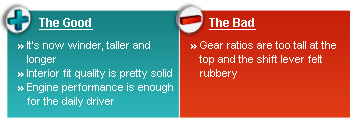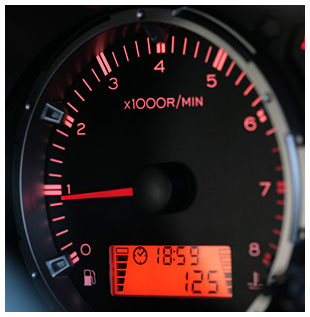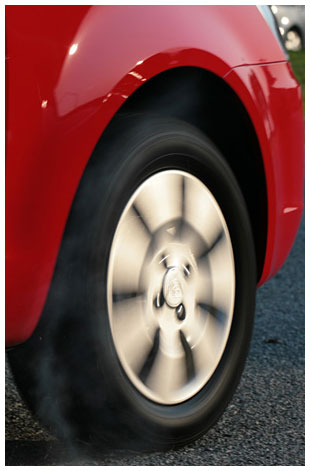Proton Saga 1.3M Review
01 Sep 2008|69,611 views
 |
It never had much to offer - a basic 1.3 or 1.5-litre engine, five-speed manual with the option of a three-speed automatic, a rough, noisy ride and great instability above 100km/h. However, it was still very, very cheap and because it sold so well, it became the motoring identity of Malaysia.
It brought mass vehicle ownership to everyone's doorstep, even if they lived in a wooden atap hut somewhere in the forest. This was important, considering the geographical size of Malaysia, and the general lack of public transport that went along with it - something most Singaporeans take for granted even till this day.
Such was the phenomenon then, that you could almost say something like "you're Malaysian, so you must drive a Proton!" and get away with it.
Fast forward to the turn of the 21st century, and things weren't looking too rosy for this national carmaker. Despite their acquisition of British performance carmaker Lotus, government funds and national protectionism meant a lack of innovation amidst increasing car prices. Other locally produced cars licensed from brands such Kia (Naza Sutera, Bestari, etc.) and Daihatsu (Perodua Kancil, Myvi, Kembara and so on) effectively took the lead in sales.
The hammer finally fell not too long ago, when the Malaysian government announced it's withdrawal of funding and protection. This meant that prices had to rise, and Proton was a hundred per cent susceptible to the rigours of competition.
Hence, the significance of the new Proton Saga - this Malaysian icon has no other choice but to return to the fundamentals of what it once was as a Malaysian carmaker. It has to cough up a car that the majority of Malaysians need, and not want - a budget-priced, economical sedan with no frills and spills.
 |
Outer workings
The new Saga is based on the potent-handling Savvy platform, penned together by a group of experts from both inside and outside of Proton in a time frame of (get this) 17 months!
The low set, rectangular front gives way to smartly-styled headlamps and lower air intakes on the bumper that remind me of a Suzuki Swift Sports, while the side of the Saga remains flat and purposeful. Those wheel arches are slightly flared for good measure, while its rear-end incorporates tail lamps that look like "kueh lapis" (Malay layered cake), leading to a nicely sculptured boot lid.
Well I must admit that the car isn't a looker of the lot, but so far so good in the simple-Simon department.
When it boils down to the numbers, you'll be surprised to know that the new Saga is actually 54mm shorter than the old one, but it is wider (by 45mm), higher (by 142mm!) and most importantly, 85mm longer in terms of wheelbase. This also explains the shorter front and rear overhang, keeping in-line with most modern sedan designs.
 Interior
Interior Rear leg and headroom in the Saga is extremely abundant. We would say, 90-percent that of a Toyota Vios. There's room for three, along with rear seatbelts. Some of this seems to have come at a sacrifice though - having gained the most in terms of height over the old model, front knee room isn't exactly very high, especially for my height of 170cm.
The dashboard plastics look deceivingly expensive, thanks to the addition of texture. Signal and wiper stalks feel really solid to operate, and you know they aren't going to break off within the next century or so. Driving position was a little to high for our taste, but visibility was excellent this way. The Mirrors do harbour a little blind-spotting here and there, but it isn't anything to be concerned about - turning your head solves the problem.
Other amenities include two cupholders in front and three at the back, a gaping hole in the passenger section of the dash for storage, glove box, door and seat pockets, and an MP3 CD player that couldn't play our own MP3s.
 |
The air-conditioning dials are simple enough to understand, and now operate with a resounding "click," but we don't really like how the vents keep closing on their own accord, especially when you set them to anything less than wide-open. The location of the cigarette lighter doesn't allow easy access for plugging in an elongated mobile-phone charger when you pile rubbish such as water bottles.
The (surprisingly manually operated) rear windows did not fully descend into the door, as was the case when we used the Proton as a photography car during one of our photo-shoots.
The boot would be the other area that left an impression - Proton's claimed luggage space of 413-litres (43-litres more) certainly lives up to its name. The loading area is rather square, making it easy to store and retrieve large items.
 Driving Impressions
Driving Impressions Proton has a new 1.3-litre "Campro IAFM," or Integrated Air Fuel Module featuring variable length manifold runners. The electrical system has also been updated with coil-on-plugs instead of the traditional ignition cable system, eliminating a good amount of power loss.
94 horses at 6,000 rpm and 120 Nm at 4,000 rpm isn't exactly anything to shout about. Its output matches that of a 1.3-litre in the Satria Neo. However, power delivery characteristics in both cars are remarkably different.
We've driven that particular car in Malaysia. It was equipped with a "non-IAFM" Campro 1.3-litre engine, the sort of power unit that needed revving to get a brisk move on. We couldn't discern any sort of push below 3,500 rpm. Now this new Campro addresses all of those problems. Don't be fooled by the slightly lower peak torque - you'll noticeably feel of it just after 2,500 rpm and all the way to 4,000 rpm.
Mated to the engine is a rather rubbery 5-speed manual from Aichi Kikai. First and second are excellent in getting the car off the line in no time. Third and fourth might be a little too wide apart though, as fifth barely sees the revs dip below 3,000 rpm when you're puttering along at around 100 km/h.
It's not geared towards the ultimate refinement at cruising speeds, but it does offer a good spread of torque everywhere, not to mention overtaking power anywhere from 80-120 km/h - good enough for Malaysians for a short highway sprint to work and back.
 |
The shift lever was a bit of a shame. It had lots of free play and felt rubbery. It was also rather tall, making the throw just as long. However, it isn't so bad because of the shortened distance from knob to steering wheel.
Now I say it was a shame, because the car's handling dynamics wasn't bad at all. There are MacPherson struts and a stabilizer bar up front with a torsion beam in the rear. It turns in sharply, holds its stance well through corners, and resists understeering to a sizeable extent. Such a waste then, that a quick shifting transmission doesn't come standard in this package!
Another observation we made was with throttle response - the Saga doesn't rev as immediately as you might want it to, especially when throttling off during gear changes. Clutch in whilst changing up from first through third, and chances are the engine will "rev up" as if your foot were still on the accelerator.
Fuel economy figures were unexpectedly good during our test drive - we emptied half a tank of petrol in the 375 or so kilometers that we've traveled. We've also managed to clock a meager 6 litres per 100 km traveled, not to mention considerably less when traveling at 80 km/h in fifth.
Passing muster
In Singapore, you could get one of these for S$41,988. For that amount of money, you get everything we've mentioned above in our review, including a driver's side airbag, 14-inch 185/60 Goodyear Ducaros, powered mirrors and a choice of red (pictured), silver, white or black.
Priced in the same league of poorly made, half-baked Chinese vehicles, we don't see why this car should have problems selling. The Proton Saga has the goods to go. There's lots of space for a family of five. It's economical. Most of all, it stands firm where build, ride quality, refinement and performance are concerned - something no car from China has been able to do so far.
We aren't just tugging at the heart strings of Malaysians either. Sure, it doesn't look like a MINI, or a stylishly designed Peugeot, but like the Volkswagen Beetle did, I have a gut feeling that the Saga will continue to soldier on as "that" iconic apparition that gave rise to the Malaysian automotive industry, once again.
 |
It never had much to offer - a basic 1.3 or 1.5-litre engine, five-speed manual with the option of a three-speed automatic, a rough, noisy ride and great instability above 100km/h. However, it was still very, very cheap and because it sold so well, it became the motoring identity of Malaysia.
It brought mass vehicle ownership to everyone's doorstep, even if they lived in a wooden atap hut somewhere in the forest. This was important, considering the geographical size of Malaysia, and the general lack of public transport that went along with it - something most Singaporeans take for granted even till this day.
Such was the phenomenon then, that you could almost say something like "you're Malaysian, so you must drive a Proton!" and get away with it.
Fast forward to the turn of the 21st century, and things weren't looking too rosy for this national carmaker. Despite their acquisition of British performance carmaker Lotus, government funds and national protectionism meant a lack of innovation amidst increasing car prices. Other locally produced cars licensed from brands such Kia (Naza Sutera, Bestari, etc.) and Daihatsu (Perodua Kancil, Myvi, Kembara and so on) effectively took the lead in sales.
The hammer finally fell not too long ago, when the Malaysian government announced it's withdrawal of funding and protection. This meant that prices had to rise, and Proton was a hundred per cent susceptible to the rigours of competition.
Hence, the significance of the new Proton Saga - this Malaysian icon has no other choice but to return to the fundamentals of what it once was as a Malaysian carmaker. It has to cough up a car that the majority of Malaysians need, and not want - a budget-priced, economical sedan with no frills and spills.
 |
Outer workings
The new Saga is based on the potent-handling Savvy platform, penned together by a group of experts from both inside and outside of Proton in a time frame of (get this) 17 months!
The low set, rectangular front gives way to smartly-styled headlamps and lower air intakes on the bumper that remind me of a Suzuki Swift Sports, while the side of the Saga remains flat and purposeful. Those wheel arches are slightly flared for good measure, while its rear-end incorporates tail lamps that look like "kueh lapis" (Malay layered cake), leading to a nicely sculptured boot lid.
Well I must admit that the car isn't a looker of the lot, but so far so good in the simple-Simon department.
When it boils down to the numbers, you'll be surprised to know that the new Saga is actually 54mm shorter than the old one, but it is wider (by 45mm), higher (by 142mm!) and most importantly, 85mm longer in terms of wheelbase. This also explains the shorter front and rear overhang, keeping in-line with most modern sedan designs.
 Interior
Interior Rear leg and headroom in the Saga is extremely abundant. We would say, 90-percent that of a Toyota Vios. There's room for three, along with rear seatbelts. Some of this seems to have come at a sacrifice though - having gained the most in terms of height over the old model, front knee room isn't exactly very high, especially for my height of 170cm.
The dashboard plastics look deceivingly expensive, thanks to the addition of texture. Signal and wiper stalks feel really solid to operate, and you know they aren't going to break off within the next century or so. Driving position was a little to high for our taste, but visibility was excellent this way. The Mirrors do harbour a little blind-spotting here and there, but it isn't anything to be concerned about - turning your head solves the problem.
Other amenities include two cupholders in front and three at the back, a gaping hole in the passenger section of the dash for storage, glove box, door and seat pockets, and an MP3 CD player that couldn't play our own MP3s.
 |
The air-conditioning dials are simple enough to understand, and now operate with a resounding "click," but we don't really like how the vents keep closing on their own accord, especially when you set them to anything less than wide-open. The location of the cigarette lighter doesn't allow easy access for plugging in an elongated mobile-phone charger when you pile rubbish such as water bottles.
The (surprisingly manually operated) rear windows did not fully descend into the door, as was the case when we used the Proton as a photography car during one of our photo-shoots.
The boot would be the other area that left an impression - Proton's claimed luggage space of 413-litres (43-litres more) certainly lives up to its name. The loading area is rather square, making it easy to store and retrieve large items.
 Driving Impressions
Driving Impressions Proton has a new 1.3-litre "Campro IAFM," or Integrated Air Fuel Module featuring variable length manifold runners. The electrical system has also been updated with coil-on-plugs instead of the traditional ignition cable system, eliminating a good amount of power loss.
94 horses at 6,000 rpm and 120 Nm at 4,000 rpm isn't exactly anything to shout about. Its output matches that of a 1.3-litre in the Satria Neo. However, power delivery characteristics in both cars are remarkably different.
We've driven that particular car in Malaysia. It was equipped with a "non-IAFM" Campro 1.3-litre engine, the sort of power unit that needed revving to get a brisk move on. We couldn't discern any sort of push below 3,500 rpm. Now this new Campro addresses all of those problems. Don't be fooled by the slightly lower peak torque - you'll noticeably feel of it just after 2,500 rpm and all the way to 4,000 rpm.
Mated to the engine is a rather rubbery 5-speed manual from Aichi Kikai. First and second are excellent in getting the car off the line in no time. Third and fourth might be a little too wide apart though, as fifth barely sees the revs dip below 3,000 rpm when you're puttering along at around 100 km/h.
It's not geared towards the ultimate refinement at cruising speeds, but it does offer a good spread of torque everywhere, not to mention overtaking power anywhere from 80-120 km/h - good enough for Malaysians for a short highway sprint to work and back.
 |
The shift lever was a bit of a shame. It had lots of free play and felt rubbery. It was also rather tall, making the throw just as long. However, it isn't so bad because of the shortened distance from knob to steering wheel.
Now I say it was a shame, because the car's handling dynamics wasn't bad at all. There are MacPherson struts and a stabilizer bar up front with a torsion beam in the rear. It turns in sharply, holds its stance well through corners, and resists understeering to a sizeable extent. Such a waste then, that a quick shifting transmission doesn't come standard in this package!
Another observation we made was with throttle response - the Saga doesn't rev as immediately as you might want it to, especially when throttling off during gear changes. Clutch in whilst changing up from first through third, and chances are the engine will "rev up" as if your foot were still on the accelerator.
Fuel economy figures were unexpectedly good during our test drive - we emptied half a tank of petrol in the 375 or so kilometers that we've traveled. We've also managed to clock a meager 6 litres per 100 km traveled, not to mention considerably less when traveling at 80 km/h in fifth.
Passing muster
In Singapore, you could get one of these for S$41,988. For that amount of money, you get everything we've mentioned above in our review, including a driver's side airbag, 14-inch 185/60 Goodyear Ducaros, powered mirrors and a choice of red (pictured), silver, white or black.
Priced in the same league of poorly made, half-baked Chinese vehicles, we don't see why this car should have problems selling. The Proton Saga has the goods to go. There's lots of space for a family of five. It's economical. Most of all, it stands firm where build, ride quality, refinement and performance are concerned - something no car from China has been able to do so far.
We aren't just tugging at the heart strings of Malaysians either. Sure, it doesn't look like a MINI, or a stylishly designed Peugeot, but like the Volkswagen Beetle did, I have a gut feeling that the Saga will continue to soldier on as "that" iconic apparition that gave rise to the Malaysian automotive industry, once again.
Car Information
Proton Saga 1.3 (M)
CAT A|Petrol|13.4km/L
Horsepower
70kW (94 bhp)
Torque
120 Nm
Acceleration
13sec (0-100km /hr)
This model is no longer being sold by local distributor
All Used Proton SagaThank You For Your Subscription.





















